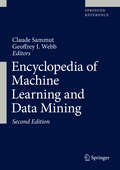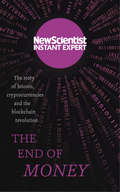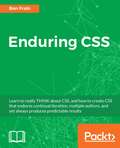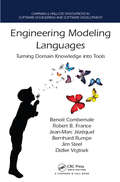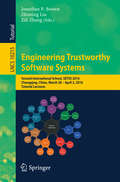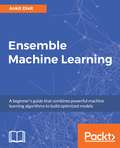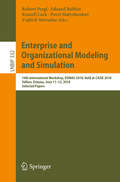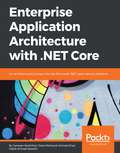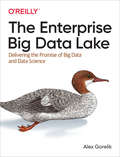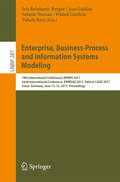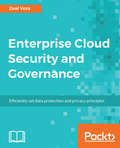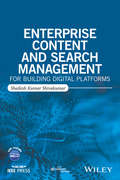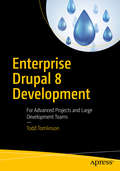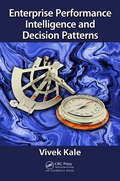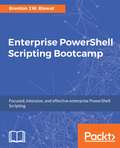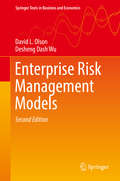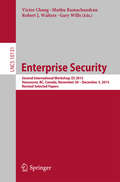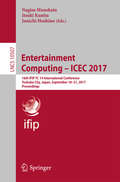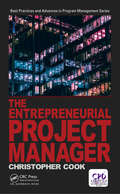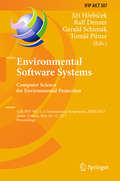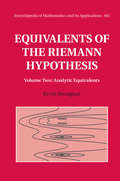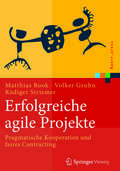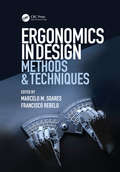- Table View
- List View
Encyclopedia of Machine Learning and Data Mining
by Claude Sammut Geoffrey I. WebbThis authoritative, expanded and updated second edition of Encyclopedia of Machine Learning and Data Mining provides easy access to core information for those seeking entry into any aspect within the broad field of Machine Learning and Data Mining. A paramount work, its 800 entries - about 150 of them newly updated or added - are filled with valuable literature references, providing the reader with a portal to more detailed information on any given topic. Topics for the Encyclopedia of Machine Learning and Data Mining include Learning and Logic, Data Mining, Applications, Text Mining, Statistical Learning, Reinforcement Learning, Pattern Mining, Graph Mining, Relational Mining, Evolutionary Computation, Information Theory, Behavior Cloning, and many others. Topics were selected by a distinguished international advisory board. Each peer-reviewed, highly-structured entry includes a definition, key words, an illustration, applications, a bibliography, and links to related literature. The entries are expository and tutorial, making this reference a practical resource for students, academics, or professionals who employ machine learning and data mining methods in their projects. Machine learning and data mining techniques have countless applications, including data science applications, and this reference is essential for anyone seeking quick access to vital information on the topic.
The End of Money: The Story of Bitcoin, Cryptocurrencies and the Blockchain Revolution (New Scientist Instant Expert)
by New Scientist<p>Murder for hire. Drug trafficking. Embezzlement. Money laundering. These might sound like plot lines of a thriller, but they are true stories from the short history of cryptocurrencies - digital currencies conceived by computer hackers and cryptographers that represent a completely new sort of financial transaction that could soon become mainstream. <p>The most famous - or infamous - cryptocurrency is bitcoin. But look beyond its tarnished reputation and something much shinier emerges. The technology that underlies bitcoin and other cryptocurrencies - the blockchain - is hailed as the greatest advancement since the invention of the internet. It is now moving away from being the backbone for a digital currency and making inroads into other core concepts of society: identity, ownership and even the rule of law. <p>The End of Money is your essential introduction to this transformative new technology that has governments, entrepreneurs and forward-thinking people from all walks of life sitting up and taking notice.</p>
Enduring CSS
by Ben FrainLearn to really THINK about CSS, and how to create CSS that endures continual iteration, multiple authors, and yet always produces predictable results About This Book • Address the problems of CSS at scale, avoiding the shortfalls of scaling CSS. • The shortfalls of conventional approaches to scaling CSS. • Develop consistent and enforceable selector naming conventions with ECSS. • Learn how to organize project structure to more easily isolate and decouple visual components. Who This Book Is For This is a book for working CSS authors involved in large projects. This is a book that tackles create enduring CSS for large-scale projects. What You Will Learn • The problems of CSS at scale—specificity, the cascade and styles intrinsically tied to element structure. • The shortfalls of conventional approaches to scaling CSS. • The ECSS methodology and the problems it solves. • How to develop consistent and enforceable selector naming conventions with ECSS. • How to organise project structure to more easily isolate and decouple visual components. • How to handle state changes in the DOM with ARIA or override selectors. • How to apply ECSS to web applications and visual modules. • Considerations of CSS tooling and processing: Sass/PostCSS and linting. • Addressing the notion of CSS selector speed with hard data and browser representative insight In Detail Learn with me, Ben Frain, about how to really THINK about CSS and how to use CSS for any size project! I'll show you how to write CSS that endures continual iteration, multiple authors, and yet always produces predictable results. Enduring CSS, often referred to as ECSS, offers you a robust and proven approach to authoring and maintaining style sheets at scale. Enduring CSS is not a book about writing CSS, as in the stuff inside the curly braces. This is a book showing you how to think about CSS, and be a smarter developer with that thinking! It's about the organisation and architecture of CSS—the parts outside the braces. I will help you think about the aspects of CSS development that become the most difficult part of writing CSS in larger projects. You'll learn about the problems of authoring CSS at scale—including specificity, the cascade and styles intrinsically tied to document structure. I'll introduce you to the ECSS methodology, and show you how to develop consistent and enforceable selector naming conventions. We'll cover how to apply ECSS to your web applications and visual model, and how you can organize your project structure wisely, and handle visual state changes with ARIA, providing greater accessibility considerations. In addition, we'll take a deep look into CSS tooling and process considerations. Finally we will address performance considerations by examining topics such as CSS selector speed with hard data and browser-representative insight. Style and approach Learn with me, Ben Frain, about how to really think about CSS. This is a book to deal with writing CSS for large-scale, rapidly changing web projects and applications. This isn't a book about writing CSS, as in the stuff inside the curly braces - this is a book about the organisation and architecture of CSS; the parts outside the braces!
Engineering Modeling Languages: Turning Domain Knowledge into Tools (Chapman & Hall/CRC Innovations in Software Engineering and Software Development Series #7590)
by Benoit Combemale Jean-Marc Jézéquel Bernhard Rumpe James Steel Robert France Didier VojtisekWritten by foremost experts in the field, Engineering Modeling Languages provides end-to-end coverage of the engineering of modeling languages to turn domain knowledge into tools. The book provides a definition of different kinds of modeling languages, their instrumentation with tools such as editors, interpreters and generators, the integration of multiple modeling languages to achieve a system view, and the validation of both models and tools. Industrial case studies, across a range of application domains, are included to attest to the benefits offered by the different techniques. The book also includes a variety of simple worked examples that introduce the techniques to the novice user. The book is structured in two main parts. The first part is organized around a flow that introduces readers to Model Driven Engineering (MDE) concepts and technologies in a pragmatic manner. It starts with definitions of modeling and MDE, and then moves into a deeper discussion of how to express the knowledge of particular domains using modeling languages to ease the development of systems in the domains. The second part of the book presents examples of applications of the model-driven approach to different types of software systems. In addition to illustrating the unification power of models in different software domains, this part demonstrates applicability from different starting points (language, business knowledge, standard, etc.) and focuses on different software engineering activities such as Requirement Engineering, Analysis, Design, Implementation, and V&V. Each chapter concludes with a small set of exercises to help the reader reflect on what was learned or to dig further into the examples. Many examples of models and code snippets are presented throughout the book, and a supplemental website features all of the models and programs (and their associated tooling) discussed in the book.
Engineering Trustworthy Software Systems
by Zili Zhang Zhiming Liu Jonathan P. BowenThis volume contains a record of some of the lectures and seminars delivered at the Second International School on Engineering Trustworthy Software Systems (SETSS 2016), held in March/April 2016 at Southwest University in Chongqing, China. The six contributions included in this volume provide an overview of leading-edge research in methods and tools for use in computer system engineering. They have been distilled from six courses and two seminars on topics such as: modelling and verification in event-B; parallel programming today; runtime verification; Java in the safety-critical domain; semantics of reactive systems; parameterized unit testing; formal reasoning about infinite data values; and Alan Turing and his remarkable achievements. The material is useful for postgraduate students, researchers, academics, and industrial engineers, who are interested in the theory and practice of methods and tools for the design and programming of trustworthy software systems.
Ensemble Machine Learning: A beginner's guide that combines powerful machine learning algorithms to build optimized models
by Radovan Kavicky Apeksha Jain Ankit DixitKey Features Learn how to maximize popular machine learning algorithms such as random forests, decision trees, AdaBoost, K-nearest neighbor, and more Get a practical approach to building efficient machine learning models using ensemble techniques with real-world use cases Implement concepts such as boosting, bagging, and stacking ensemble methods to improve your model prediction accuracy Book Description Ensembling is a technique of combining two or more similar or dissimilar machine learning algorithms to create a model that delivers superior prediction power. This book will show you how you can use many weak algorithms to make a strong predictive model. This book contains Python code for different machine learning algorithms so that you can easily understand and implement it in your own systems. This book covers different machine learning algorithms that are widely used in the practical world to make predictions and classifications. It addresses different aspects of a prediction framework, such as data pre-processing, model training, validation of the model, and more. You will gain knowledge of different machine learning aspects such as bagging (decision trees and random forests), Boosting (Ada-boost) and stacking (a combination of bagging and boosting algorithms). Then you’ll learn how to implement them by building ensemble models using TensorFlow and Python libraries such as scikit-learn and NumPy. As machine learning touches almost every field of the digital world, you’ll see how these algorithms can be used in different applications such as computer vision, speech recognition, making recommendations, grouping and document classification, fitting regression on data, and more. By the end of this book, you’ll understand how to combine machine learning algorithms to work behind the scenes and reduce challenges and common problems. What you will learn -Understand why bagging improves classification and regression performance -Get to grips with implementing AdaBoost and different variants of this algorithm -See the bootstrap method and its application to bagging -Perform regression on Boston housing data using scikit-learn and NumPy -Know how to use Random forest for IRIS data classification -Get to grips with the classification of sonar dataset using KNN, Perceptron, and Logistic Regression -Discover how to improve prediction accuracy by fine-tuning the model parameters -Master the analysis of a trained predictive model for over-fitting/under-fitting cases
Enterprise and Organizational Modeling and Simulation: 13th International Workshop, Eomas 2017, Held At Caise 2017, Essen, Germany, June 12-13, 2017, Selected Papers (Lecture Notes in Business Information Processing #298)
by Vojtěch Merunka Pavel Malyzhenkov Russell Lock Eduard Babkin Robert PerglThis book constitutes the refereed proceedings of the 14th International Workshop on Enterprise and Organizational Modeling and Simulation, EOMAS 2018, held in Tallinn, Estonia, in June 2018. The main focus of EOMAS is on the role, importance, and application of modeling and simulation within the extended organizational and enterprise context. The 11 full papers presented in this volume were carefully reviewed and selected from 22 submissions. They were organized in topical sections on conceptual modeling, enterprise engineering, and formal methods.
Enterprise Application Architecture with .NET Core
by Ovais Mehboob Khan Ganesan Senthilvel Habib Ahmed QureshiArchitect and design highly scalable, robust, clean and highly performant applications in .NET Core 1.0 About This Book • Incorporate architectural soft-skills such as DevOps and Agile methodologies to enhance program-level objectives • Gain knowledge of architectural approaches on the likes of SOA architecture and microservices to provide traceability and rationale for architectural decisions • Explore a variety of practical use cases and code examples to implement the tools and techniques described in the book Who This Book Is For This book is for experienced .NET developers who are aspiring to become architects of enterprise-grade applications, as well as software architects who would like to leverage .NET to create effective blueprints of applications. What You Will Learn • Grasp the important aspects and best practices of application lifecycle management • Leverage the popular ALM tools, application insights, and their usage to monitor performance, testability, and optimization tools in an enterprise • Explore various authentication models such as social media-based authentication, 2FA and OpenID Connect, learn authorization techniques • Explore Azure with various solution approaches for Microservices and Serverless architecture along with Docker containers • Gain knowledge about the recent market trends and practices and how they can be achieved with .NET Core and Microsoft tools and technologies In Detail If you want to design and develop enterprise applications using .NET Core as the development framework and learn about industry-wide best practices and guidelines, then this book is for you. The book starts with a brief introduction to enterprise architecture, which will help you to understand what enterprise architecture is and what the key components are. It will then teach you about the types of patterns and the principles of software development, and explain the various aspects of distributed computing to keep your applications effective and scalable. These chapters act as a catalyst to start the practical implementation, and design and develop applications using different architectural approaches, such as layered architecture, service oriented architecture, microservices and cloud-specific solutions. Gradually, you will learn about the different approaches and models of the Security framework and explore various authentication models and authorization techniques, such as social media-based authentication and safe storage using app secrets. By the end of the book, you will get to know the concepts and usage of the emerging fields, such as DevOps, BigData, architectural practices, and Artificial Intelligence. Style and approach Filled with examples and use cases, this guide takes a no-nonsense approach to show you the best tools and techniques required to become a successful software architect.
The Enterprise Big Data Lake: Delivering the Promise of Big Data and Data Science
by Alex GorelikEnterprises are experimenting with using Hadoop to build Big Data Lakes, but many projects are stalling or failing because the approaches that worked at Internet companies have to be adopted for the enterprise. This practical handbook guides managers and IT professionals from the initial research and decision-making process through planning, choosing products, and implementing, maintaining, and governing the modern data lake.You'll explore various approaches to starting and growing a Data Lake, including Data Warehouse off-loading, analytical sandboxes, and "Data Puddles." Author Alex Gorelik shows you methods for setting up different tiers of data, from raw untreated landing areas to carefully managed and summarized data. You'll learn how to enable self-service to help users find, understand, and provision data; how to provide different interfaces to users with different skill levels; and how to do all of that in compliance with enterprise data governance policies.
Enterprise, Business-Process and Information Systems Modeling: 18th International Conference, BPMDS 2017, 22nd International Conference, EMMSAD 2017, Held at CAiSE 2017, Essen, Germany, June 12-13, 2017, Proceedings (Lecture Notes in Business Information Processing #287)
by Iris Reinhartz-Berger, Jens Gulden, Selmin Nurcan, Wided Guédria and Palash BeraThis book constitutes the proceedings of two events held in conjunction with the CAiSE conferences and related to the areas of enterprise, business-process and information systems modeling: the 18th International Conference on Business Process Modeling, Development and Support, BPMDS 2017, and the 22nd International Conference on Evaluation and Modeling Methods for Systems Analysis and Development, EMMSAD, 2017. They took place in Essen, Germany, in June 2017. The focus theme for BPMDS 2017 papers was “Enabling Business Transformation by Business Process Modeling, Development and Support". From 24 submitted papers, 11 were finally accepted and organized by: Non-functional considerations in business processes; new challenges in business process modeling and support; testing business processes; business process model comprehension; an experience report on teaching business process modeling. The EMMSAD conference focuses on evaluating, exploring and enhancing modeling methods and techniques for the development of information and software systems, enterprises, and business processes. It received 25 submissions, from which 9 full and 2 short papers were selected and organized: evaluation and comparison of modeling languages and methods; modeling approaches to support decision making; behavioral specification and business process modeling; and modeling languages and methods in evolving context.
Enterprise Cloud Security and Governance: Efficiently set data protection and privacy principles
by Adrian Pruteanu Zeal VoraKey Features Gain a firm grasp of Cloud data security and governance, irrespective of your Cloud platform Practical examples to ensure you secure your Cloud environment efficiently A step-by-step guide that will teach you the unique techniques and methodologies of Cloud data governance Book Description Modern day businesses and enterprises are moving to the Cloud, to improve efficiency and speed, achieve flexibility and cost effectiveness, and for on-demand Cloud services. However, enterprise Cloud security remains a major concern because migrating to the public Cloud requires transferring some control over organizational assets to the Cloud provider. There are chances these assets can be mismanaged and therefore, as a Cloud security professional, you need to be armed with techniques to help businesses minimize the risks and misuse of business data. The book starts with the basics of Cloud security and offers an understanding of various policies, governance, and compliance challenges in Cloud. This helps you build a strong foundation before you dive deep into understanding what it takes to design a secured network infrastructure and a well-architected application using various security services in the Cloud environment. Automating security tasks, such as Server Hardening with Ansible, and other automation services, such as Monit, will monitor other security daemons and take the necessary action in case these security daemons are stopped maliciously. In short, this book has everything you need to secure your Cloud environment with. It is your ticket to obtain industry-adopted best practices for developing a secure, highly available, and fault-tolerant architecture for organizations. What you will learn Configure your firewall and Network ACL Protect your system against DDOS and application-level attacks Explore cryptography and data security for your cloud Get to grips with configuration management tools to automate your security tasks Perform vulnerability scanning with the help of the standard tools in the industry Learn about central log management
Enterprise Content and Search Management for Building Digital Platforms
by Shailesh Kumar ShivakumarProvides modern enterprises with the tools to create a robust digital platform utilizing proven best practices, practical models, and time-tested techniques Contemporary business organizations can either embrace the digital revolution—or be left behind. Enterprise Content and Search Management for Building Digital Platforms provides modern enterprises with the necessary tools to create a robust digital platform utilizing proven best practices, practical models, and time-tested techniques to compete in the today’s digital world. Features include comprehensive discussions on content strategy, content key performance indicators (KPIs), mobile-first strategy, content assessment models, various practical techniques and methodologies successfully used in real-world digital programs, relevant case studies, and more. Initial chapters cover core concepts of a content management system (CMS), including content strategy; CMS architecture, templates, and workflow; reference architectures, information architecture, taxonomy, and content metadata. Advanced CMS topics are then covered, with chapters on integration, content standards, digital asset management (DAM), document management, and content migration, evaluation, validation, maintenance, analytics, SEO, security, infrastructure, and performance. The basics of enterprise search technologies are explored next, and address enterprise search architecture, advanced search, operations, and governance. Final chapters then focus on enterprise program management and feature coverage of various concepts of digital program management and best practices—along with an illuminating end-to-end digital program case study. Comprehensive and cutting-edge, Enterprise Content and Search Management for Building Digital Platforms is an invaluable reference resource for creating an optimal enterprise digital eco-system to meet the challenges of today’s hyper-connected world.
Enterprise Drupal 8 Development
by Todd TomlinsonSuccessfully architect a Drupal 8 website that scales to meet project requirements of any size and scope. Starting with a one-chapter review of Drupal basics, you'll dive into deeper topics including software development processes, architecting a Drupal site, scaling Drupal, working effectively with themes, and more. In addition to a thorough discussion of custom module development and how to develop modules as building blocks, you'll also review many common ways of integrating Drupal with other 3rd party systems.Building and maintaining an enterprise-ready Drupal website presents a unique set of challenges and complexities. From development processes and content management to deployments, version control and more, all aspects of Drupal development are impacted when two or more developers are on a project. If you are involved in a Drupal project that requires frequent updates and long-term support from a team of developers, system administrators, and end-users, Enterprise Drupal 8 Development is for you. Whether you're an experienced Drupal developer looking to expand your skills, a systems administrator managing a Drupal project, or a PHP developer new to Drupal, Enterprise Drupal 8 Development will give you the knowledge and inspiration you need to manage large and complex projects.What You'll LearnArchitect Drupal for development teams and apply best practices for large Drupal projectsIntegrate 3rd party applications with DrupalManage content, code, and configuration across multiple staging environmentsBuild a consistent user experience for administrators and content creatorsWho This Book Is ForThe primary audience is intermediate to advanced Drupal developers who are working on large-scale Drupal projects and advanced PHP developers new to DrupalThe secondary audience is IT Professionals such as Systems Administrators managing Drupal projects
Enterprise Performance Intelligence and Decision Patterns
by Vivek Kale"Vivek Kale has written a great book on performance management that focuses on decision-making; on continuous, incremental improvement; and on identifying common patterns in becoming a more intelligent organization." —James Taylor, CEO of Decision Management Solutions and author of Real-World Decision Modeling with DMN "Introducing the concepts of decision patterns and performance intelligence, Vivek Kale has written another important book on the issues faced by contemporary organizations."—Gary Cokins, author of Predictive Business Analytics and Performance Management: Integrating Strategy Execution, Methodologies, Risk, and Analytics Enterprise Performance Intelligence and Decision Patterns unravels the mystery of enterprise performance intelligence (EPI) and explains how it can transform the operating context of business enterprises. It provides a clear understanding of what EPI means, what it can do, and application areas where it is practical to use. The need to be responsive to evolving customer needs and desires creates organizational structures where business intelligence (BI) and decision making is pushed out to operating units that are closest to the scene of the action. Closed-loop decision making resulting from a combination of on-going performance management with on-going BI can lead to an effective responsive enterprise; hence, the need for performance intelligence (PI). This pragmatic book: Introduces the technologies such as data warehousing, data mining, analytics, and business intelligence systems that are a first step toward enabling data-driven enterprises. Details decision patterns and performance decision patterns that pave the road for performance intelligence applications. Introduces the concepts, principles, and technologies related to performance measurement systems. Describes the concepts and principles related to balance scorecard systems (BCS). Introduces aspects of performance intelligence for the real-time enterprises. Enterprise Performance Intelligence and Decision Patterns shows how a company can design and implement instruments ranging from decision patterns to PI systems that can enable continuous correction of business unit behavior so companies can enhance levels of productivity and profitability.
Enterprise PowerShell Scripting Bootcamp
by Brenton J.W. BlawatThe quick start guide for an advanced enterprise PowerShell framework About This Book • Introduces industry-proven techniques that improve script efficiency and reliability • Example-rich guide based on real-world scenarios • Facilitates building a script that can fully scan a Windows server and identify components Who This Book Is For This book is for IT professionals and Windows administrators who would like to gain intensive, hands-on knowledge and skills on PowerShell without spending hours and hours in learning. If you have been struggling to find the time to gain proficiency and confidence with PowerShell and everyday scripting tasks What You Will Learn • Create an advanced PowerShell scripting template that provides repeatable code to jumpstart all of your scripting projects • Learn how to securely encrypt and store usernames, passwords, and other sensitive data in PowerShell scripts and answer files • Understand how to optimize the performance of scripts to help process large datasets quickly and avoid time-consuming mistakes • Develop a script to scan for non-standard Windows Server configurations and identify service accounts used on Windows Servers • Gather a large list of data from a Windows server without locally or remotely logging in interactively In Detail Enterprise PowerShell Scripting Bootcamp explains how to create your own repeatable PowerShell scripting framework. This framework contains script logging methodologies, answer file interactions, and string encryption and decryption strategies. This book focuses on evaluating individual components to identify the system's function, role, and unique characteristics. To do this, you will leverage built-in CMDlets and Windows Management Instrumentation (WMI) to explore Windows services, Windows processes, Windows features, scheduled tasks, and disk statistics. You will also create custom functions to perform a deep search for specific strings in files and evaluate installed software through executable properties. We will then discuss different scripting techniques to improve the efficiency of scripts. By leveraging several small changes to your code, you can increase the execution performance by over 130%. By the end of this book, you will be able to tie all of the concepts together in a PowerShell-based Windows server scanning script. This discovery script will be able to scan a Windows server to identify a multitude of components. Style and approach This book is all about fast and intensive learning. This means, we don't waste time in helping readers get started. The new content is about leveraging highly-effective examples to build new things, help solving problems in newer and unseen ways, and providing an enterprise-ready platform to create PowerShell Scripts.
Enterprise Risk Management Models (Springer Texts in Business and Economics)
by David L. Olson Desheng Dash WuThis book is a comprehensive guide to several aspects of risk, including information systems, disaster management, supply chain and disaster management perspectives. A major portion of this book is devoted to presenting a number of operations research models that have been (or could be) applied to enterprise supply risk management, especially from the supply chain perspective. Each chapter of this book can be used as a unique module on a different topics with dedicated examples, definitions and discussion notes.This book comes at a time when the world is increasingly challenged by different forms of risk and how to manage them. Events of the 21st Century have made enterprise risk management even more critical. Risks such as suspicions surrounding top-management structures, financial and technology bubbles (especially since 2008), as well as the demonstrated risk from terrorism, such as the 9/11 attack in the U.S. as well as more recent events in France, Belgium, and other locations in Europe, have a tremendous impact on many facets of business. Businesses, in fact, exist to cope with risk in their area of specialization.
Enterprise Security
by Gary Wills Robert J. Walters Muthu Ramachandran Victor ChangEnterprise security is an important area since all types of organizations require secure and robust environments, platforms and services to work with people, data and computing applications. The book provides selected papers of the Second International Workshop on Enterprise Security held in Vancouver, Canada, November 30-December 3, 2016 in conjunction with CloudCom 2015. The 11 papers were selected from 24 submissions and provide a comprehensive research into various areas of enterprise security such as protection of data, privacy and rights, data ownership, trust, unauthorized access and big data ownership, studies and analysis to reduce risks imposed by data leakage, hacking and challenges of Cloud forensics.
Entertainment Computing – ICEC 2017: 16th Ifip Tc 14 International Conference, Tsukuba City, Japan, September 18-21, 2017, Proceedings (Lecture Notes in Computer Science #10507)
by Nagisa Munekata Itsuki Kunita Junichi HoshinoThis book constitutes the refereed proceedings of the 16th International Conference on Entertainment Computing, ICEC 2017, held in Tsukuba City, Japan, in September 2017. The 16 full papers, 13 short papers, and 2 posters presented were carefully reviewed and selected from 46 submissions.
The Entrepreneurial Project Manager (Best Practices in Portfolio, Program, and Project Management)
by Chris CookDoing more with less is a skill mastered by entrepreneurs. Budgets are tight, deadlines are short, and time is of the essence. Entrepreneurial project managers use these parameters to their benefit. Hurdling over obstacles with the bare minimum of effort makes their projects and teams stand out. Focusing inward to develop the skills and mindset necessary to accomplish anything with anyone sets an entrepreneurial project manager apart from the group. This book builds on the basics of project management knowledge with tools and techniques to get you as well as your projects and teams performing on an advanced level. No matter your industry or experience level, this book gives you practical ways to improve any project. More importantly, it shows how you can improve your own performance. The biggest improvements a project manager can make are about him- or herself. Personal limitations can be the hardest obstacle to overcome, and this book explains how to overcome them. The techniques have been tried and tested by the author who shares them with you in this book. Whether in your projects or career, all the right things can be said and done, yet the results are always unpredictable. We all have little control over events. This book’s tools and techniques give you the ability to handle anything that may come your way. Entrepreneurs are constantly changing and adapting to the world around them. They must stay cutting-edge to make their businesses thrive. This book explains how to take a cutting-edge approach to project management. The goal is to take your technical skills as a project manager, add the elements of an entrepreneur, and create a high-powered team around you as well as become the best project manager you can be.
Environmental Software Systems. Computer Science for Environmental Protection: 12th Ifip Wg 5. 11 International Symposium, Isess 2017, Zadar, Croatia, May 10-12, 2017, Proceedings (IFIP Advances in Information and Communication Technology #507)
by Jiří Hřebíček Ralf Denzer Gerald Schimak Tomáš PitnerThis book constitutes the refereed proceedings of the 12th IFIP WG 5.11 International Symposium on Environmental Software Systems, ISESS 2017, held in Zadar, Croatia, in May 2017. The 35 revised full papers presented together with 4 keynote lectures were carefully reviewed and selected from 46 submissions. The papers deal with environmental challenges and try to provide solutions using forward-looking and leading-edge IT technology. They are organized in the following topical sections: air and climate; water and hydrosphere; health and biosphere; risk and disaster management; information systems; and modelling, visualization and decision support.
Épica aventura de rap del frikismo: El micrófono perdido de Keyblade
by KeybladeUn viaje lleno de aventuras que los seguidores de Keyblade disfrutarán al máximo. Keyblade deberá superar muchas pruebas en una peligrosa odisea con batallas de rap y la ayuda de una dragona y otras divertidas criaturas fantásticas ¡No te pierdas esta épica aventura de rap del frikismo! Keyblade tiene claro que lo más importante es concentrarse al grabar los raps del frikismo para su canal en YouTube, a menos que... su cama lo convenza de tomar una pequeña siesta. Pero echarse un sueñito no es la mejor de las ideas, pues al despertar descubre que ¡su micrófono ha desaparecido! Y no es cualquier micro: es su compañero, su arma, su todo. ¡Tiene que recuperarlo! Sin él, su canal de YouTube, sus fans, el equilibrio cósmico... ¡Todo está en peligro!
Equivalents of the Riemann Hypothesis: Arithmetic Equivalents (Encyclopedia of Mathematics and its Applications #164)
by Kevin BroughanThe Riemann hypothesis (RH) is perhaps the most important outstanding problem in mathematics. This two-volume text presents the main known equivalents to RH using analytic and computational methods. The book is gentle on the reader with definitions repeated, proofs split into logical sections, and graphical descriptions of the relations between different results. It also includes extensive tables, supplementary computational tools, and open problems suitable for research. Accompanying software is free to download. These books will interest mathematicians who wish to update their knowledge, graduate and senior undergraduate students seeking accessible research problems in number theory, and others who want to explore and extend results computationally. Each volume can be read independently. Volume 1 presents classical and modern arithmetic equivalents to RH, with some analytic methods. Volume 2 covers equivalences with a strong analytic orientation, supported by an extensive set of appendices containing fully developed proofs. Gives students and researchers easy access to methods and results. Fully describes approaches to the Riemann hypothesis using arithmetic functions. Provides many unsolved problems suitable for research. Tailored software is freely available online.
Equivalents of the Riemann Hypothesis: Analytic Equivalents (Encyclopedia of Mathematics and its Applications #165)
by Kevin BroughanThe Riemann hypothesis (RH) is perhaps the most important outstanding problem in mathematics. This two-volume text presents the main known equivalents to RH using analytic and computational methods. The book is gentle on the reader with definitions repeated, proofs split into logical sections, and graphical descriptions of the relations between different results. It also includes extensive tables, supplementary computational tools, and open problems suitable for research. Accompanying software is free to download. These books will interest mathematicians who wish to update their knowledge, graduate and senior undergraduate students seeking accessible research problems in number theory, and others who want to explore and extend results computationally. Each volume can be read independently. Volume 1 presents classical and modern arithmetic equivalents to RH, with some analytic methods. Volume 2 covers equivalences with a strong analytic orientation, supported by an extensive set of appendices containing fully developed proofs. Gives students and researchers easy access to methods and results. Fully describes approaches to the Riemann hypothesis using arithmetic functions. Provides many unsolved problems suitable for research. Tailored software is freely available online.
Erfolgreiche agile Projekte: Pragmatische Kooperation und faires Contracting (Xpert.press)
by Matthias Book Volker Gruhn Rüdiger StriemerDas Buch beschreibt pragmatische Instrumente und Methoden, die Software-Entwicklern und Fachexperten dabei helfen, ein gemeinsames Problem- und L#65533;sungsverst#65533;ndnis zu entwickeln und Projekte so zu managen, dass Risiken fair zwischen Auftraggeber und Auftragnehmer verteilt werden. Teil 1 beleuchtet kurz die agile Entwicklungspraxis im kommerziellen Umfeld. Teil 2 beschreibt den Interaction Room, in dem Entwickler und Fachexperten auf gleicher Augenh#65533;he zusammenarbeiten. Teil 3 beschreibt das Preis- und Vertragsmodell adVANTAGE, das die Br#65533;cke zwischen agiler Philosophie und vertraglich fixierten Leistungserwartungen schl#65533;gt. Teil 4 illustriert die Methoden am Beispiel einer industriellen Fallstudie, bevor Teil 5 ein modernes Qualifikationsprofil aufstellt. Das Buch wendet sich an CIOs, Projektmanager und Entwickler, die Risiken in ihren Projekten fr#65533;her erkennen, souver#65533;ner mit der Ungewissheit komplexer Projekte umgehen und effektiver mit Kunden bzw. Dienstleistern kooperieren wollen.
Ergonomics in Design: Methods and Techniques (Human Factors and Ergonomics)
by Francisco Rebelo Marcelo M. SoaresCurrently people deal with various entities (such as hardware, software, buildings, spaces, communities and other people), to meet specific goals while going about their everyday activities in work and leisure environments. These entities have become more and more complex and incorporate functions that hitherto had never been allocated such as automation, use in virtual environments, connectivity, personalization, mobility and friendliness. This book contributes to the analysis of human-system interactions from the perspective of ergonomics, regardless of how simple or complex they are, while incorporating the needs of users and workers in a healthy safe, efficient and enjoyable manner. This book provides a comprehensive review of the state of the art of current ergonomic in design methods and techniques that are being applied to products, machinery, equipment, workstations and systems while taking new technologies and their applications into consideration. Ergonomics in Design: Methods and Techniques is organized into four sections and 30 chapters covering topics such as conceptual aspects of ergonomics in design, the knowledge of human characteristics applied to design, and the methodological aspects of design. Examples are shown in several areas of design including, but not limited to, consumer products, games, transport, education, architecture, fashion, sustainability, biomechanics, intelligent systems, virtual reality, and neurodesign. This book will: Introduces the newest developments in social-cultural approaches Shows different ergonomics in design methodological approaches Divulges the ways that ergonomics can contribute to a successful design Applies different subjects to support the design including –ergonomics, engineering, architecture, urbanism, neuro, and product designs. Presents recent technologies in ergonomic design, as applied to product design. With the contributions from a team of 75 researchers from 11 countries, the book covers the state-of-the-art of ergonomics in a way to produce better design.
